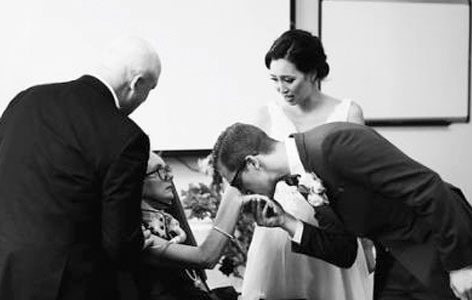
By Michael Chang, ORT Times Writer and UHN Trainee
It was an intense moment of joy, that’s all I recall when Miles Montgomery shared with me that his PhD research in Dr. Milica Radisic's lab was published and featured on the cover of Nature Materials [1]. Miles had recently designed a novel elastic patch that could be seeded with live cells, rolled up, and injected into the body through a small syringe to potentially repair damaged organs. His team had successfully shown the patch’s ability to improve the function of the damaged heart in a rodent model. Additionally, they had demonstrated, without adverse side effects, the successful attachment of the elastic patch seeded with viable human cardiac cells on to the porcine heart.
It is incredible to realize this research can be directly applicable to all tissue types, though Miles focused particularly on cardiac tissue given the prevalence of heart attacks in Canada (~55,000 Canadians affected each year) [2]. Clinical trials on the use of heart patches in treating heart attack patients are limited, as inserting the patches requires invasive surgery and the high risks associated with the surgery outweigh the benefits. Also, dozens of human clinical trials that rely on non-invasive injections of various cell suspensions into the damaged heart (post-heart attack) have produced underwhelming results [3]. Miles’ new elastic patch has the potential to address both these outstanding issues. His innovation has the potential to improve the quality of life for patients with end-stage organ damage and eliminate the need for invasive surgical procedures when repairing damaged organ tissue. It was an exciting time in Miles’ life: he was thinking of starting a biomedical company to commercialize his research and planning for his wedding with his college sweetheart.
Then came an intense moment of woe, that’s all I recall when I witnessed Miles turn pale white. He had received a phone call informing him that his mother had been in a serious accident that, among other life-threatening injuries, had completely severed her spinal cord at the third thoracic vertebra. She had become completely paralyzed from the chest down. Sadly, Miles’ mother would not be attending his wedding; the special purple dress she had picked out for the occasion would remain unworn. Fortunately, with the permission of Sunnybrook Hospital, Miles and his fiancé went on to hold a charming ceremony in the Department of Critical Care Medicine while his mother watched in her beautiful purple dress.
Later at the wedding reception, I will never forget the chill that ran through my body after Miles shared with me that he was considering leaving biomaterials research to study spinal cord injury. I was shocked by his proposition of parting with a field in which he was beginning to show so much promise in. I recall once being in awe of Miles’ character when I learned that he pursued cardiac research because heart disease is a serious burden for one-third of the world’s population [4]. Still, I remain in awe, because I realize that he now wants to pursue medical research for just one person: his mother.
References:
1. Montgomery, M., et al., Flexible shape-memory scaffold for minimally invasive delivery of functional tissues. Nature Materials, 2017. 16(10): p. 1038-1046.
2. Shanmugasegaram, S., S. Dai, and C. Waters, Incidence and prevalence of acute myocardial infarction in canadian provinces and territories. Canadian Journal of Cardiology, 2015. 31(10): p. S44.
3. Nguyen, P.K., J.-W. Rhee, and J.C. Wu, Adult stem cell therapy and heart failure, 2000 to 2016: a systematic review. JAMA Cardiology, 2016. 1(7): p. 831-841.
4. “Cardiovascular Disease, World Health Organization, www.who.int/cardiovascular_diseases/en/.




